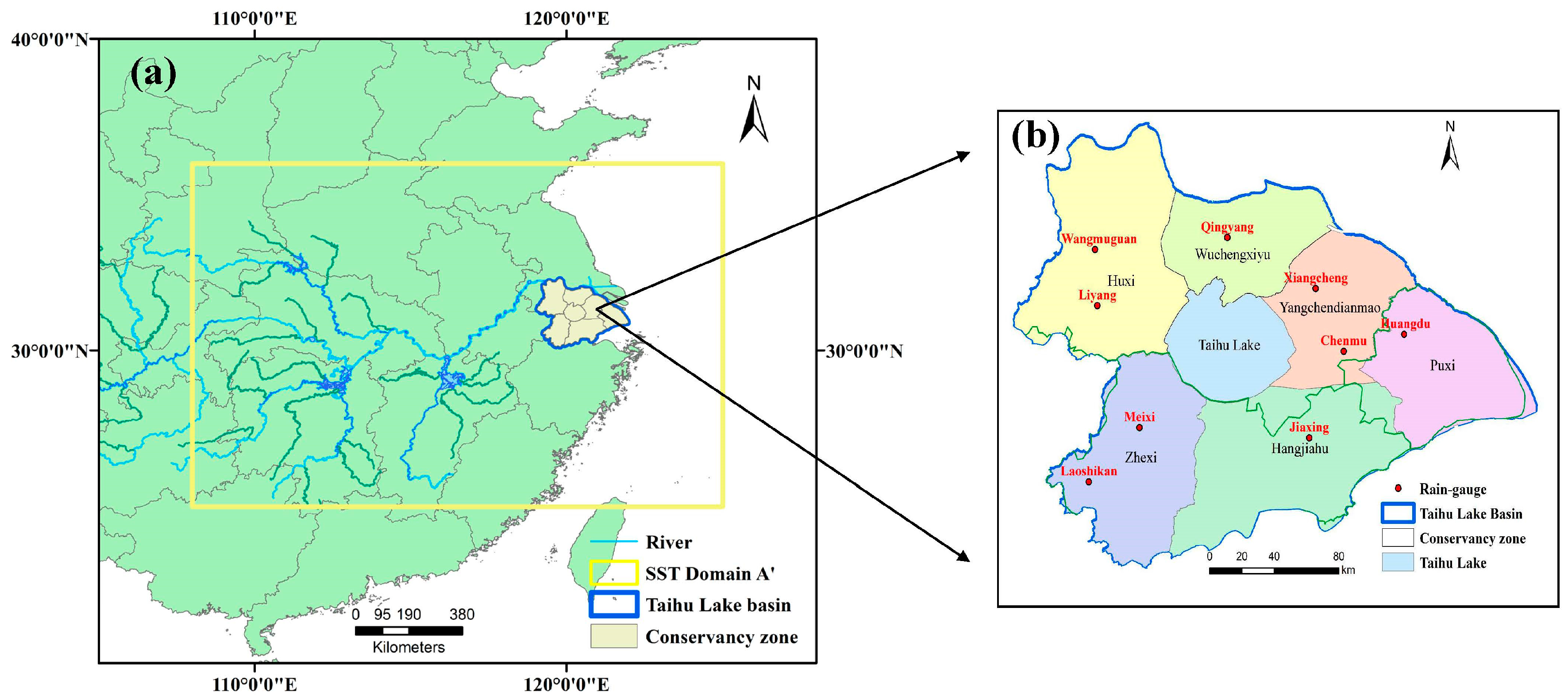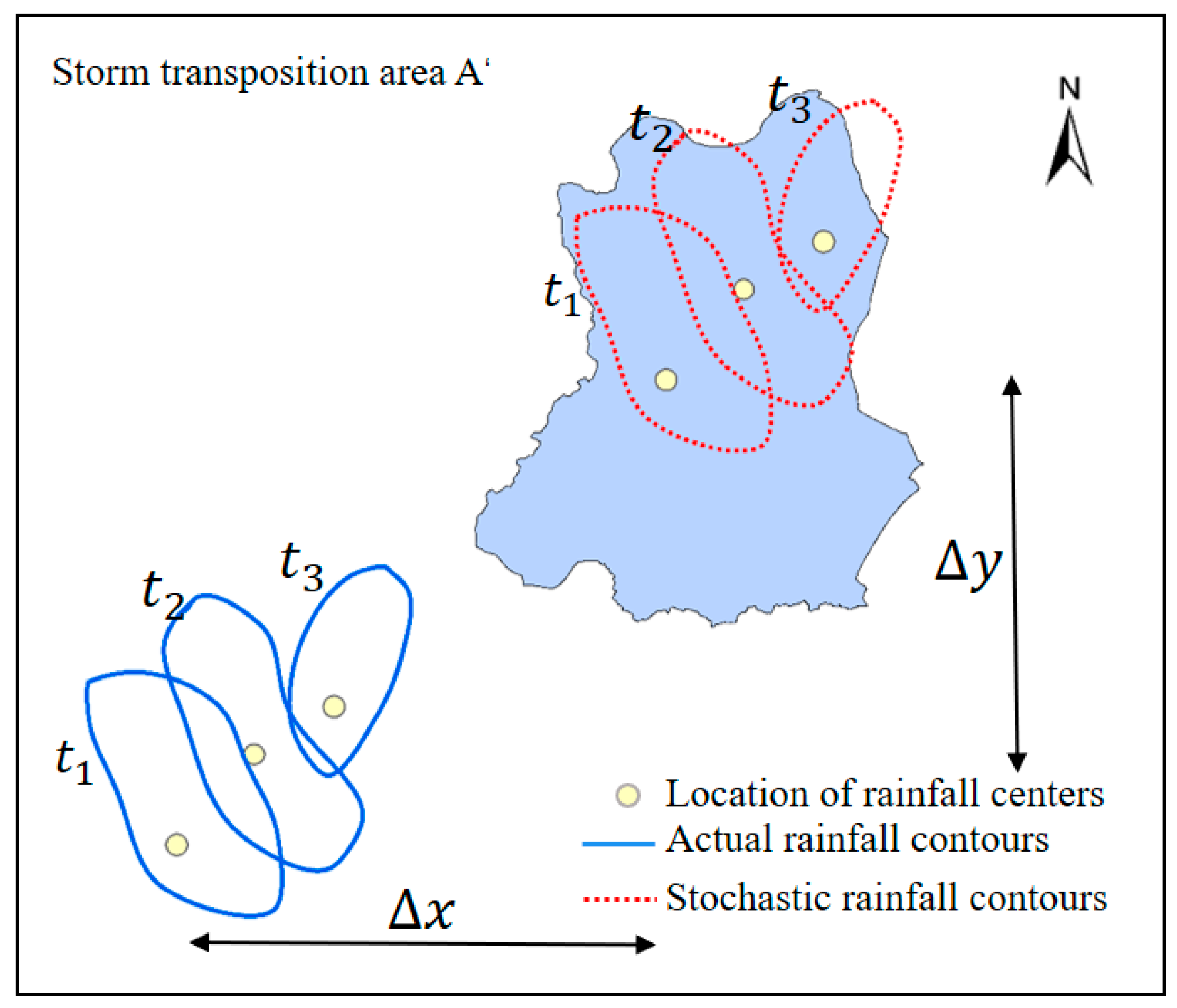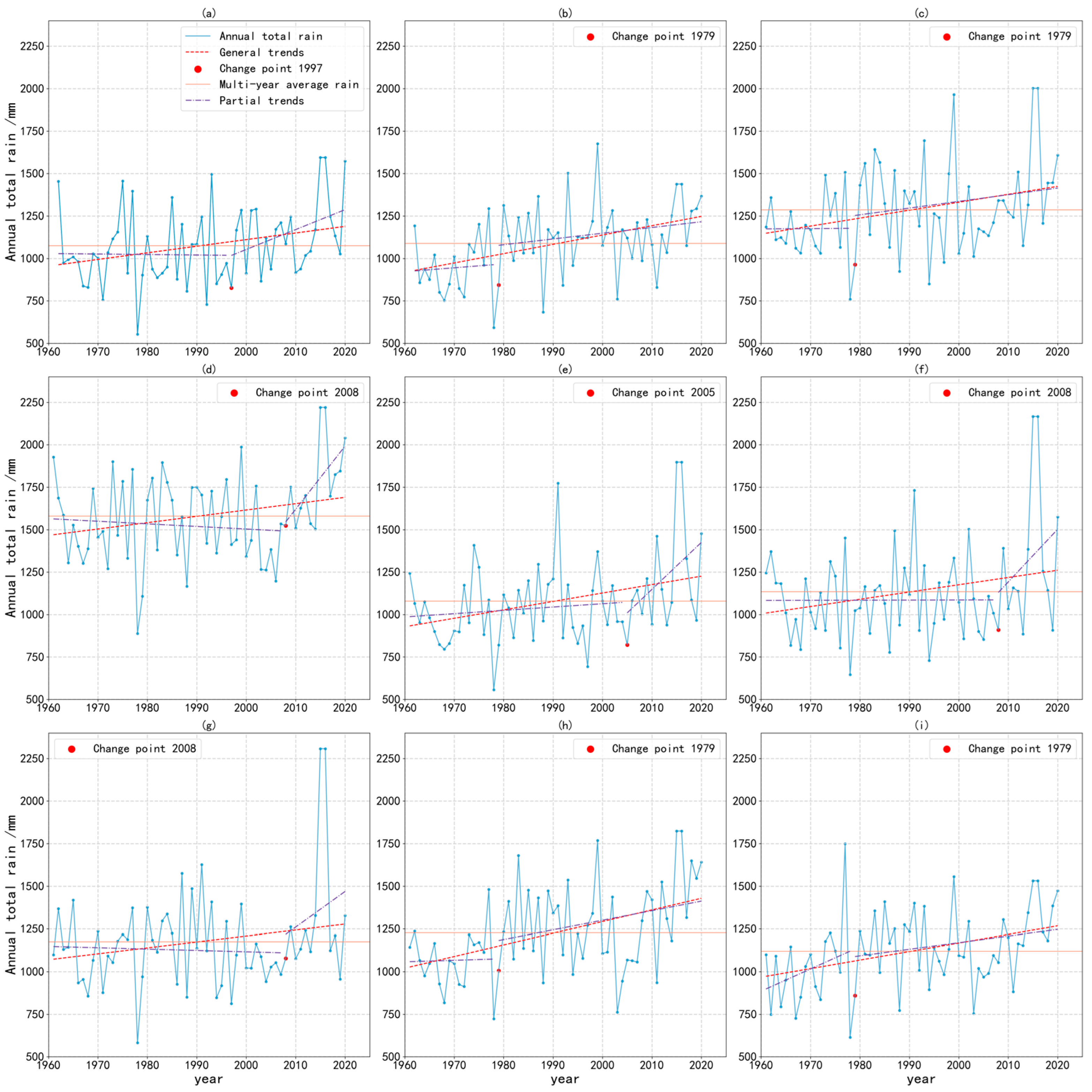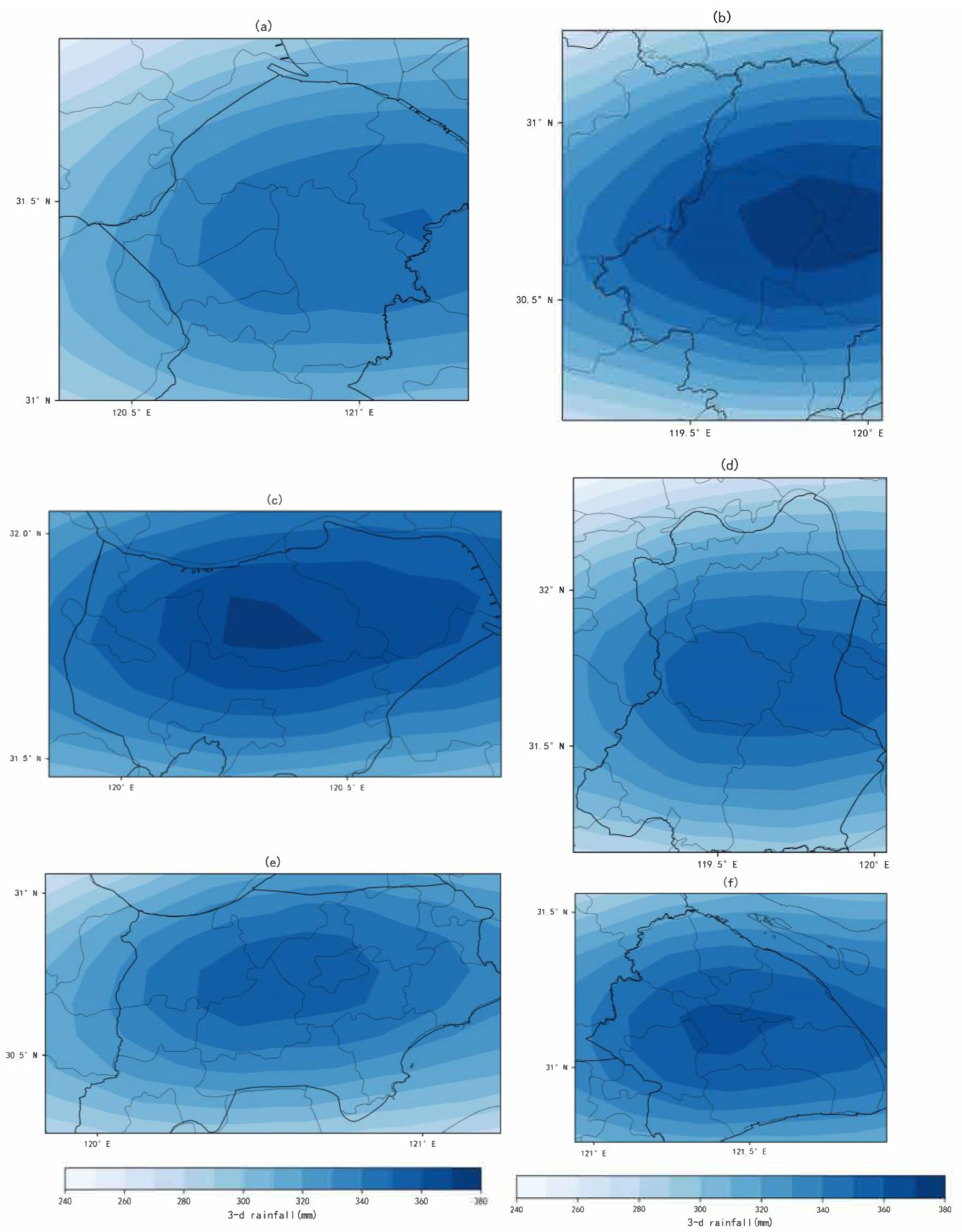Nonstationary Frequency Analysis of Extreme Rainfall in the Taihu Lake Basin, China †
Abstract
:1. Introduction
2. Materials and Methods
2.1. Study Area and Data
2.2. Research Methods
2.2.1. Nonstationary Analysis
2.2.2. Stochastic Storm Transposition (SST) Method
3. Results and Discussion
3.1. Nonstationary Analysis
3.1.1. Annual Rainfall Analysis
3.1.2. Extreme Rainfall Analysis
3.2. SST-Based Rainfall Frequency Analysis
4. Conclusions
Author Contributions
Funding
Institutional Review Board Statement
Informed Consent Statement
Data Availability Statement
Conflicts of Interest
References
- IPCC. Climate Change 2022: Impacts, Adaptation and Vulnerability; IPCC: Paris, France, 2022. [Google Scholar]
- Zuo, H.; Lu, S.; Hu, Q. Trend analysis of temperature and precipitation in China in the last 50 years. Plateau Weather 2004, 2, 238–244. [Google Scholar]
- Dai, S.; Zhang, Y. Flooding characteristics and mitigation measures in Taihu Lake Basin. In Proceedings of the Taihu Advanced Forum, Shanghai, China, 2 December 2004; pp. 88–93. [Google Scholar]
- Taihu Basin Authority of Ministry of Water Resources. Taihu Lake Basin and Southeast Rivers Water Resources Bulletin 2018; Taihu Basin Authority of MWR: Shanghai, China, 2019.
- LI, L.; Hu, Q.; Wang, Y.; Liu, Y.; Zhu, Y.; Wang, L.; Cui, T. Spatial and temporal distribution characteristics of water production changes in the Taihu Lake basin during rapid urbanization. Lake Sci. 2019, 31, 1289–1298. [Google Scholar]
- Zhan, Y. Taihu Lake Basin Wucheng Xiyu District Flood Control Planning. Master’s Thesis, Hohai University, Nanjing, China, 2005. [Google Scholar]
- Wang, C.; Zhai, P. Preliminary analysis of changes in extreme heavy precipitation events in major cities in China. Clim. Environ. Stud. 2009, 14, 553–560. [Google Scholar]
- Ji, X.; Na, Y.; Xia, C.; Shuai, C.; Yu, B.; Lin, B. Application of the generalized cumulative rainfall percentage method to the study of design storm rain patterns in the Taihu Lake region. Jiangsu Water Resour. 2020, 284, 29–32. [Google Scholar] [CrossRef]
- Smith, J.A.; Baeck, M.L.; Villarini, G.; Welty, C.; Miller, A.J.; Krajewski, W.F. Analyses of a long-term, high-resolution radar rainfall data set for the Baltimore metropolitan region. Water Resour. Res. 2012, 48. [Google Scholar] [CrossRef]
- Wright, D.B.; Smith, J.A.; Villarini, G.; Baeck, M.L. Long-term high-resolution radar rainfall fields for urban hydrology. J. Am. Water Resour. Assoc. 2014, 50, 713–734. [Google Scholar] [CrossRef]
- Yang, L.; Tian, F.Q.; Smith, J.A.; Hu, H.P. Urbansignatures in thespatial clusteringof summer heavy rainfall events over the Beijing metropolitan region. J. Geophys. Res.-Atmos. 2014, 119, 1203–1217. [Google Scholar] [CrossRef]
- Zhou, Z.; Smith, J.A.; Wright, D.B.; Baeck, M.L.; Yang, L.; Liu, S. Storm Catalog-Based Analysis of Rainfall Heterogeneity and Frequency in a Complex Terrain. Water Resour. Res. 2019, 55, 1871–1889. [Google Scholar] [CrossRef]
- Zhuang, Q.; Zhou, Z.; Liu, S.; Wright, D.B.; Araruna Junior, J.T.; Makhinov, A.N.; Makhinova, A.F. Bivariate rainfall frequency analysis in an urban Watershed: Combining copula theory with stochastic storm transposition. J. Hydrol. 2022, 615, 128648. [Google Scholar] [CrossRef]
- Kendall, M.G. Rank Correlation Methods, 2nd ed.; Springer: Berlin/Heidelberg, Germany, 1955. [Google Scholar]
- Liu, X.; Zhou, Y.; Lu, Q.; Zhao, Z.; Wen, W.; Li, C.; Wang, H.; Lu, Y.; Song, W.; Qiao, L. Method for Determining Anti-Floating and Anti-Water level Based on Mann-Kendall Trend Analysis, Involves Defining Mann-Kendall Trend Test Statistic, Calculating Z-Value of Mann-Kendall Trend Analysis Statistical Variable. CN Patent CN111877416-A, 20 November 2020. [Google Scholar]
- Pettitt, A.N. A Non-Parametric Approach to the Change-Point Problem. J. R. Stat. Soc. 1979, 28, 126–135. [Google Scholar] [CrossRef]
- Mann, H.B. Nonparametric test against trend. Econometrica 1945, 13, 245–259. [Google Scholar] [CrossRef]
- Mood, A.M. The Distribution Theory of Runs. Ann. Math. Stat. 1940, 11, 367–392. [Google Scholar] [CrossRef]
- Zhou, Z.; Liu, S.; Wright, D.B. Analysis of urban design storm based on stochastic storm transposition. Adv. Water Sci. 2020, 31, 583–591. [Google Scholar] [CrossRef]
- Wright, D.B.; Smith, J.A.; Villarini, G.; Baeck, M.L. Estimating the frequency of extreme rainfall using weather radar and stochastic storm transposition. J. Hydrol. 2013, 488, 150–165. [Google Scholar] [CrossRef]
- Zhuang, Q.; Liu, S.; Zhou, Z. The Change of Spatio-Temporal Precipitation and Rainfall Frequency Analysis in Shanghai. J. China Hydrol. 2021, 41, 74–80. [Google Scholar] [CrossRef]
- Wu, Y.; Zhang, Z.; Jin, Q. Accuracy evaluation of GPM precipitation product in Yangtze River basin. Yangtze River 2019, 50, 77–85+152. [Google Scholar] [CrossRef]
- Huffman, G.J.; Stocker, E.F.; Bolvin, D.T.; Nelkin, E.J.; Tan, J. GPM IMERG Early Precipitation L3 Half Hourly 0.1 Degree x 0.1 Degree V06; Goddard Earth Sciences Data and Information Services Center (GES DISC): Greenbelt, MD, USA, 2019.






| Water Conservancy Zone | Rain Gauge | Trend | Change Point | Significance Test |
|---|---|---|---|---|
| Yangchendianmao | Xiangcheng | increasing | 1997 | × |
| Chenmu | increasing | 1979 | √ | |
| Zhexi | Meixi | increasing | 1979 | × |
| Laoshikan | increasing | 2008 | × | |
| Wuchengxiyu | Qingyang | increasing | 2005 | × |
| Huxi | Wangmuguan | no trend | 2008 | × |
| Liyang | no trend | 2008 | × | |
| Huangjiahu | Jiaxing | increasing | 1979 | √ |
| Puxi | Huangdu | increasing | 1979 | √ |
Disclaimer/Publisher’s Note: The statements, opinions and data contained in all publications are solely those of the individual author(s) and contributor(s) and not of MDPI and/or the editor(s). MDPI and/or the editor(s) disclaim responsibility for any injury to people or property resulting from any ideas, methods, instructions or products referred to in the content. |
© 2023 by the authors. Licensee MDPI, Basel, Switzerland. This article is an open access article distributed under the terms and conditions of the Creative Commons Attribution (CC BY) license (https://creativecommons.org/licenses/by/4.0/).
Share and Cite
Jin, Y.; Liu, S.; Zhou, Z.; Zhuang, Q.; Zhong, G. Nonstationary Frequency Analysis of Extreme Rainfall in the Taihu Lake Basin, China. Eng. Proc. 2023, 39, 45. https://doi.org/10.3390/engproc2023039045
Jin Y, Liu S, Zhou Z, Zhuang Q, Zhong G. Nonstationary Frequency Analysis of Extreme Rainfall in the Taihu Lake Basin, China. Engineering Proceedings. 2023; 39(1):45. https://doi.org/10.3390/engproc2023039045
Chicago/Turabian StyleJin, Yuting, Shuguang Liu, Zhengzheng Zhou, Qi Zhuang, and Guihui Zhong. 2023. "Nonstationary Frequency Analysis of Extreme Rainfall in the Taihu Lake Basin, China" Engineering Proceedings 39, no. 1: 45. https://doi.org/10.3390/engproc2023039045
APA StyleJin, Y., Liu, S., Zhou, Z., Zhuang, Q., & Zhong, G. (2023). Nonstationary Frequency Analysis of Extreme Rainfall in the Taihu Lake Basin, China. Engineering Proceedings, 39(1), 45. https://doi.org/10.3390/engproc2023039045







